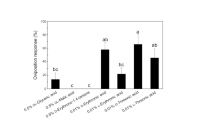Abstract
Bioassay-guided fractionations of a dichloromethane extract of wheat epicuticular wax allowed the identification of 1-octacosanal and 6-methoxy-2-benzoxazolinone (MBOA) as the major components that stimulate oviposition by the Hessian fly, Mayetiola destructor. These compounds were identified by their mass spectral fragmentation patterns and by comparison of their gas chromatographic retention times with synthetic samples. Synthetic samples of 1-octacosanal or MBOA stimulated significant oviposition when compared with solvent controls. In combination, these compounds elicited a synergistic effect on the number of eggs laid by females compared to when they were presented alone. In a choice bioassay, a mixture of synthetic 1-octacosanal and MBOA in the approximate concentrations determined to be present in one plant equivalent of crude extract stimulated the same amount of oviposition as one plant equivalent of extract. This showed that together these two compounds appear to be responsible for the major proportion of the ovipositional stimulatory activity of the wheat epicuticular wax extract. Comparison of the activity of five straight-chain primary aldehydes with chain lengths from C22 to C30 revealed a relationship between chain length and the number of eggs laid by female Hessian flies, with 1-hexacosanal and 1-heptacosanal the most active of the aldehydes tested.
Similar content being viewed by others
REFERENCES
Atkinson, J., Morand, P., Arnason, J. T., Niemeyer, H. M., Bravo, H. R. 1991. Analogues of the cyclic hydroxamic acid 2,4-dihydroxy 7-methoxy-2H-1,4-benzoxazin-3-one: Decomposition to benzoxazolinones and reaction with b-mercaptoethanol. J. Org. Chem. 56:1788–1800.
Barnes, H. F. 1956. Gall Midges of Economic Importance: Gall Midges of Cereal Crops, Vol VII. Crosby Lockwood and Son, London.
Bergh, J. C., Harris, M. O., and Rose, S. 1992. Temporal patterns of emergence and reproductive behaviour of the Hessian fly (Diptera: Cecidomyiidae). Ann. Entomol. Soc. Am. 83:998–1004.
Bernklau, E. J., and Bjostad, L. B. 1998. Reinvestigation of host location by western corn rootworm larvae (Coleoptera: Chrysomelidae): CO2 is the only volatile attractant. J. Econ. Entomol. 91:1331–1340.
Bianchi, G. 1985. Epicuticular wax analysis in Triticum and related species. Genet. Agric. 39:471–486.
Bianchi, G., and Corbellini, M. 1977. Epicuticular wax of Triticum aestivum Demar 4. Phytochemistry 16:943–945.
Bianchi, G., and Figini, M. L. 1986. Epicuticular waxes of glaucous and nonglaucous durum wheat lines. J. Agric. Food Chem. 34:429–433.
Bianchi, G., Lupotto, E., and Corbellini, M. 1979. Composition of epicuticular waxes of Triticum aestivum Demar 4 from different parts of the plant. Agrochimica 23:96–102.
Bianchi, G., Lupotto, E., Borghi, B., and Corbellini, M. 1980. Cuticular wax of wheat. Planta 148:328–331.
Bjostad, L. B., and Hibbard, B. E. 1992. 6-Methoxy-2-benzoxazolinone: A semiochemical for host location by western corn rootworm larvae. J. Chem. Ecol. 18:931–944.
Bravo, H. R., and Niemeyer, H. M. 1985. Decomposition in aprotic solvents of 2,4-dihydroxy-7-methoxy-1,4-benzoxazin-3-one, a hydroxamic acid from cereals. Tetrahedron 41:4983–4986.
Corey, E. J., and Suggs, J. W. 1975. Pyridinium chlorochromate. An efficient reagent for oxidation of primary and secondary alcohols to carbonyl compounds. Tetrahedron Lett. 31:2647–2650.
Foster, S. P., and Harris, M. O. 1992. Foliar chemicals of wheat and related grasses influencing oviposition by Hessian Fly, Mayetiola destructor (Say) (Diptera: Cecidomyiidae). J. Chem. Ecol. 18:1965–1980.
Harris, M. O., and Rose, S. 1989. Temporal changes in the egglaying behaviour of the Hessian fly. Entomol. Exp. Appl. 53:17–29.
Harris, M. O., and Rose, S. 1990. Chemical, color and tactile cues influencing oviposition behaviour of the Hessian Fly (Diptera: Cecidomyiidae). Environ. Entomol. 19:303–308.
Harris, M. O., and Rose, S. 1991. Factors influencing the onset of egg-laying in a cecidomyiid fly. Physiol. Entomol. 16:183–190.
Harris, M. O., Dando, J. L., Griffin, and Madie, C. 1996. Susceptibility of cereal and noncereal grasses to attack by Hessian fly [Mayetiola destructor (Say)]. N.Z. J. Crop Hortic Sci. 24:229–238.
Leszczynski, B., and Dixon, A. F. G. 1990. Resistance of cereals to aphids: Interaction between hydroxamic acids and the aphid Sitobion avenae (Homoptera: Aphididae). Ann. Appl. Biol. 117:21–30.
Morrill, W. L. 1982. Hessian fly: Host selection and behaviour during oviposition, winter biology, and parisitoids. J. Ga. Entomol. Soc. 17:156–167.
Niemeyer, H. M. 1988. Hydroxamic acids (4-hydroxy-1,4-benzoxazin-3-ones), defense chemicals in the Gramineae. Phytochemistry 27:3349–3358.
Ratcliffe, R. H., and Hatchett, J. H. 1997. Biology and genetics of the Hessian fly and resistance in wheat, pp. 47–56, in K. Bobdari (ed.). New Developments in Entomology. Research Signpost, Scientific Information Guild, Trivandrum, India.
SAS Institute. 1995. JMP Statistics Discovery Software, Version 3.1. SAS Institute Inc., Cary, North Carolina.
Tulloch, A. P., and Hoffman, L. L. 1971. Leaf wax of durum wheat. Phytochemistry 10: 871–876.
Tulloch, A. P., and Hoffman, L. L. 1973. Leaf wax of Triticum aestivum. Phytochemistry 12:2217–2223.
von Wettstein-Knowles, K. 1974. Gene mutation in barley inhibiting the production and use of C26 chains in epicuticular wax formation. FEBS Lett. 42:187–191.
ZÚÑiga, G. E., and Massardo, F. 1991. Hydroxamic acid content in undifferentiated and differentiated tissues of wheat. Phytochemistry 30:3281–3283.
Author information
Authors and Affiliations
Rights and permissions
About this article
Cite this article
Morris, B.D., Foster, S.P. & Harris, M.O. Identification of 1-Octacosanal and 6-Methoxy-2-Benzoxazolinone from Wheat as Ovipositional Stimulants for Hessian Fly, Mayetiola destructor. J Chem Ecol 26, 859–873 (2000). https://doi.org/10.1023/A:1005499907009
Issue Date:
DOI: https://doi.org/10.1023/A:1005499907009




